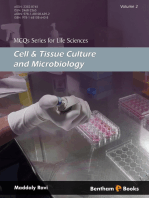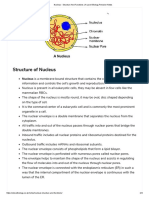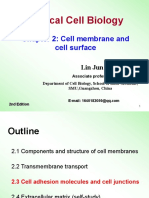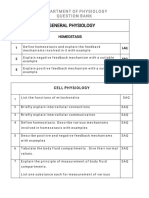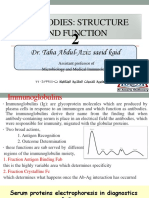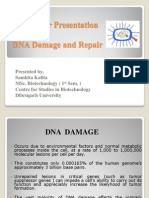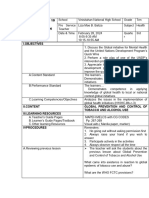Nucleus
Uploaded by
Ayesha SaleemNucleus
Uploaded by
Ayesha SaleemCell Biology
Nucleus
Nucleus
The nucleus is usually the most prominent organelle in a eukaryotic cell viewed with a light
microscope. The nucleus may provide valuable information about the cell in which it occurs.
Shape, Structure and Position of Nucleus
Most cells only contain 1 nucleus, so the locations and distributions of nuclei identify the
locations and distributions of cells in tissues and organs. A few cells (skeletal muscle cells and
osteoclasts) normally contain multiple nuclei. Multinucleated cells may originate either from
fusion of mononuclear cells or from incomplete division. Mature, mammalian red blood cells lack
a nucleus altogether.
The nucleus is usually centrally located in a cell. Location of the nucleus at one end of a cell
indicates an accumulation of organelles (secretory granules, mitochondria, etc.) at the other end
of the cell.
The nucleus is usually spherical. Extreme cell shapes may constrict the nucleus in the same
directions that the cell is constricted, giving a clear hint of cell shape. A few cells such as
granulocytes in the blood have complex nuclear shapes which are not related to cell shape, but
the nuclear morphology of these cells is one of the major ways of recognizing them.
The staining intensity of the nucleus usually reflects the state of activity of the cell. In general,
cells with larger proportions of potentially transcriptionally active DNA will have larger and
lighter staining nuclei, while cells with little or no potentially transcriptionally active DNA will
have smaller and darker staining nuclei.
1. Nuclear Envelope
The nucleus is enclosed by a nuclear envelope, which contains
nuclear pores that control the flow of materials between the nucleus
and the cytoplasm.
The nuclear envelope is comprised of two concentric unit
membranes that are separated by a narrow (25 to 70 nm) space.
The outer membrane is often studded with ribosomes and may be
continuous with the rough endoplasmic reticulum.
2. Nuclear Lamina
On the inside of the inner membrane, the nuclear lamina is present.
The nuclear lamina is a fibrous sheath, composed of specialized
intermediate filaments called lamins that provide the nucleus with
mechanical strength.
3. Nuclear Pores
At intervals, circular nuclear pores interrupt the nuclear envelope.
Materials pass through these pores in a manner that is strictly
controlled by proteins of the nuclear pore complex. In this way,
protein synthesis is restricted to the cytoplasm, permitting the
nucleus to process and refine messenger ribonucleic acids (RNAs)
without risking their translation into proteins during processing.
4. Chromatin
Chromatin consists of DNA (genetic material), histones (basic proteins with a
structural role), and non-histone proteins (acidic or neutral proteins with a
regulatory role).
The histones are involved in chromatin packing.
Non-histone proteins are also involved in chromatin packing and protection or
that participate in regulation of DNA duplication, transcription, and repair.
Chromatin exists in two states which differ in the degree of packing of DNA and
histones and non-histone proteins.
(1) Euchromatin
(a) Euchromatin is dispersed or fully extended chromatin.
(b) Appears unstained in routine LM preparations and usually appears as scattered
fine dark dots in routine TEM preparations.
(c) Consists of chromatin that is potentially transcriptionally active (i.e., potentially
involved in mRNA, rRNA, or tRNA synthesis).
(2) Heterochromatin
(a) Heterochromatin is condensed or coiled chromatin.
(b) Heterochromatin appears strongly basophilic in routine LM preparations and is
darkly stained in routine TEM preparations.
(c) Heterochromatin is usually transcriptionally inactive
The proportion of euchromatin and heterochromatin is related to the
transcriptional activity of the nucleus and affects the extent of
basophilic staining detectable with LM.
Nuclei of most cells contain both forms of chromatin, with most of the
chromatin being heterochromatin. Nuclei of most cells therefore
contain strongly basophilic areas mixed with lighter areas. If all, or
most, of the chromatin in a nucleus is transcriptionally active then all,
or most, of the chromatin will exist as euchromatin and the nucleus
will appear unstained or lightly stained at the LM level.
If all, or most, of the chromatin in a nucleus is transcriptionally
inactive then, all or most, of the chromatin will be in the form of
heterochromatin. The nucleus will therefore appear highly basophilic
at the LM level.
Conversion of all of the chromatin in the nucleus into
heterochromatin is usually indicative of irreversible cessation of
nuclear activity, and the cell is usually viable for only a short period
of time following the loss of nuclear activity.
In all cells of female
individuals, one of the two X
chromosomes is permanently
inactivated and does not Barr body
participate in transcription.
The inactive X chromosome
is recognizable in epithelial
cells from the oral cavity as a
single granule called sex
chromatin (Barr body) that is
attached to the nuclear
lamina.
In neutrophils, the sex
chromatin takes the form of a
drum stick-like appendage to
the nucleus. These structures
have been used for gender
testing.
Nucleolus
The nucleoli are prominent, spherical structures composed of protein,
RNA and small amount of DNA.
Involved in production of major components of ribosomes (rRNA).
At the light microscopic level, nucleoli range up to 1 µm in diameter and
usually stain with basic dyes such as hematoxylin, depending on their
RNA content.
The number of nucleoli is determined by the number of active nucleolar
organizing regions (NORs), which are chromosomal regions responsible
for encoding ribosomal RNA (rRNA).
Normally, there are fewer nucleoli than NORs because either some NORs
are inactivated or several fuse to form one nucleolus.
At the electron microscopic level, nucleoli have areas of varying electron
density. A granular component (Pars granulosa) representing maturing
ribosomal subunits is often prominent.
Fibrillar components (Pars fibrosa) representing NOR DNA and
transcribed rRNA are also observed. Nucleoli, along with nuclear
chromatin, are dispersed in a nuclear sap consisting of water, ions, free
nucleotides, RNA, and protein.
You might also like
- MCQ On Cytology - Cell and Cell Organelles MCQ Biology - Learning Biology Through MCQs100% (2)MCQ On Cytology - Cell and Cell Organelles MCQ Biology - Learning Biology Through MCQs5 pages
- Nucleus - Structure and Functions - A-Level Biology Revision Notes PDF50% (2)Nucleus - Structure and Functions - A-Level Biology Revision Notes PDF2 pages
- Chromosomal Aberrations: Deficiency or DeletionNo ratings yetChromosomal Aberrations: Deficiency or Deletion4 pages
- Batrachospermum One of The Best Topic of BotanyNo ratings yetBatrachospermum One of The Best Topic of Botany49 pages
- DNA Repair From Lehninger - Addtnlnotes PDFNo ratings yetDNA Repair From Lehninger - Addtnlnotes PDF13 pages
- Analytical Techniques in Plant Science-1326100% (1)Analytical Techniques in Plant Science-13263 pages
- Virus: Discovery and Characteristics With Structures, Shapes and ClassificationNo ratings yetVirus: Discovery and Characteristics With Structures, Shapes and Classification5 pages
- Comparative Study of Integument in Vertebrates100% (2)Comparative Study of Integument in Vertebrates2 pages
- Report On The Visit To National Dairy Research InstituteNo ratings yetReport On The Visit To National Dairy Research Institute15 pages
- MY 1st Sem. Presttn DNA Damage & Repair PPT MW 2003100% (1)MY 1st Sem. Presttn DNA Damage & Repair PPT MW 200326 pages
- Denaturation and Renaturation of Ribonuclease - Unit4 A - Lecture - Unit 4No ratings yetDenaturation and Renaturation of Ribonuclease - Unit4 A - Lecture - Unit 418 pages
- Biology - Class Xii - Split-Up-Syllabus - 2024-25No ratings yetBiology - Class Xii - Split-Up-Syllabus - 2024-255 pages
- WWW - Ccsuniversity.ac - in New Common-Syllabus ZoologyNo ratings yetWWW - Ccsuniversity.ac - in New Common-Syllabus Zoology20 pages
- An Extension To The EVLN Model The Role of Employees' SilenceNo ratings yetAn Extension To The EVLN Model The Role of Employees' Silence18 pages
- (DONE) FINAL PROJECT TEMPLATE OF ASSIGNMENT COVERNo ratings yet(DONE) FINAL PROJECT TEMPLATE OF ASSIGNMENT COVER5 pages
- BTI_with_AI_Brochure_for_Feb23_24_12_2024_1_cdbca90359No ratings yetBTI_with_AI_Brochure_for_Feb23_24_12_2024_1_cdbca9035922 pages
- Test Bank For Sensation and Perception 8th Edition: Goldstein100% (1)Test Bank For Sensation and Perception 8th Edition: Goldstein41 pages
- Chapter 1 The Information System: An Accountant's PerspectiveNo ratings yetChapter 1 The Information System: An Accountant's Perspective41 pages
- Collaborative Learning Questionnaire MustNo ratings yetCollaborative Learning Questionnaire Must295 pages
- Research Tool: Presented by Josfeena Bashir Ph.D. Scholar100% (1)Research Tool: Presented by Josfeena Bashir Ph.D. Scholar21 pages
- Serbian Studies Research, Vol. 6, No. 1, 2015No ratings yetSerbian Studies Research, Vol. 6, No. 1, 2015268 pages
- Data Science With Python Workflow: Click The Links For DocumentationNo ratings yetData Science With Python Workflow: Click The Links For Documentation2 pages

